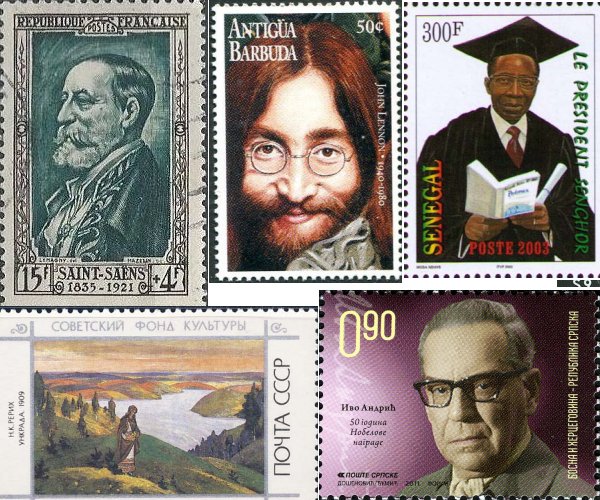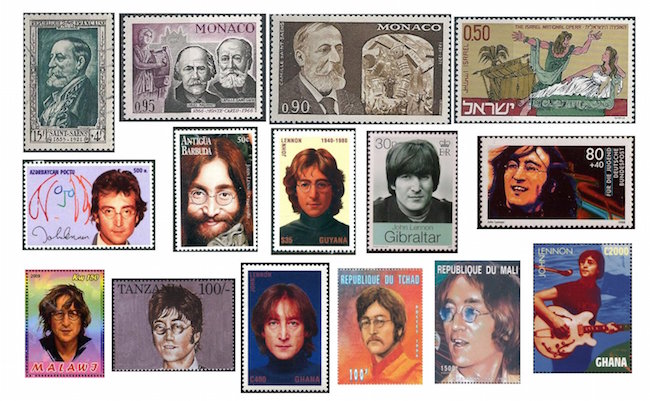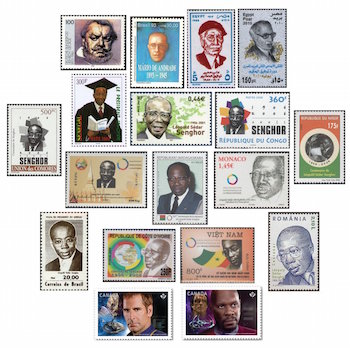The Arts on Stamps of the World —October 9
An Arts Fuse regular feature: the arts on stamps of the world.

By Doug Briscoe
October 9 is the birthday of Camille Saint-Saëns (1835–1921). The earliest stamp is his honor was printed by France in 1952. Monaco has released two stamps featuring Saint-Saëns. The one showing him with Massenet comes from a 1966 set commemorating the centenary of the founding of Monte Carlo. The other was issued just six years later to mark the 50th anniversary of Saint-Saëns’ death; it shows a scene from his most famous opera, Samson and Delilah. Israel gives us the same work on a stamp issued in 1971 to recognize the Israel National Opera.
John Lennon (9 October 1940 – 8 December 1980) is a pretty popular guy, too, if postage stamps are any indication. From a host of them I chose examples from Azerbaijan, Antigua and Barbuda, Guyana, Gibraltar, Germany, Malawi, Tanzania, Ghana (2), Chad, and Mali. How beloved the man was!
Th extraordinary Russian polymath Nicholas Roerich (October 9, 1874 – December 13, 1947) was born to an ethnic Baltic German father and a Russian mother in Saint Petersburg. (The Russian rendering of his name is given as as Nikolai Konstantinovich Rerikh). He not only excelled as a painter, but designed sets for Diaghilev’s Ballet Russes (Borodin’s Prince Igor and Stravinsky’s Rite of Spring), wrote an important treatise on architecture, and worked as an archaeologist. He also devoted much time to mysticism, theosophy, hypnosis, and so on. During the Revolution he worked to preserve the nation’s architectural heritage. But ill health and disillusionment led him to emigrate with his family to Finland as early as 1918. From there they passed on to England, meeting H. G. Wells and Rabindranath Tagore, whose grand-niece would marry Roerich’s son. He was in the US from 1920-23 at the invitation of the Chicago Art Institute, designed a 1922 production of Rimsky-Korsakov’s Snow Maiden for his new friend soprano Mary Garden, and settled in New York, but not for long. Off they went on a five-year expedition to Asia, where Roerich hoped to create a pie-in-the-sky utopia he called the Sacred Union of the East, Buddhist-based and Bolshevik-patronized. Not surprisingly, it was a non-starter. At one point the expedition was incommunicado for a year—they had been detained in Tibet for months, were poorly fed, and housed in freezing tents, as a result of which five members of the group died. Undaunted, Roerich in 1934 undertook another expedition to Mongolia, Manchuria, and China, this time under the auspices of the U.S. Department of Agriculture, to collect seeds! In the meantime Roerich was thrice nominated for the Nobel Peace Prize. There is a Nicholas Roerich Museum containing many of his paintings in New York City. A pair of Roerich stamps from the last days of the Soviet Union show two canvases: Unkrada (1909) and Pskovo-Pechorsky Monastery (1907). Roerich spent the Second World War living in India, painting, and died there at the age of 73.
And while we are in India, we salute the revolutionary, social worker, journalist, and poet Gopabandhu Das (1877 – 17 June 1928), who was known as Utkalamani (Gem of Odisha). Of course, our focus here is on the writing, although in so doing we overlook his indefatigable activism in the areas of health, education, labor unions, and social improvement generally, as well as his political life. He founded a monthly magazine in 1914 and a weekly (now daily) newspaper in 1919. I gather his poems were written in the Odia language.

Serbian writer Ivo Andrić (9 October 1892 – 13 March 1975) was awarded the Nobel Prize in Literature in 1961. He published poems from the age of 19 and translated Strindberg and Whitman shortly thereafter. As a Slavic nationalist he was active politically and was even a good friend of Gavrilo Princip, the assassin of Archduke Ferdinand. He was arrested as a co-conspirator but released after about nine months, though he was exiled and kept under house arrest or close surveillance until 1917. He published his first book, a volume of prose poetry, in 1918. Andrić had already been suffering from tuberculosis for some time, but continued writing and learning languages during his frequent spells of illness. As the child of Catholic Croats, he served the new Kingdom of Serbs, Croats and Slovenes in the diplomatic mission to the Vatican (later also in Bucharest and Trieste). Having studied years before in Vienna, he resumed his education at the University of Graz in 1923, aged 30. His first short story collection came out in 1924. His diplomatic assignments took him to Marseille, Paris, Madrid, Brussels, Geneva, and, in 1939, Berlin. There he criticized Yugoslavia’s signing of the Tripartite Pact with Germany and Italy and was relieved of his duties. After Germany’s invasion of Yugoslavia he was offered the opportunity to escape to Switzerland but declined. He resumed public life only after the Germans withdrew from the country. His novel The Bridge on the Drina (Na Drini ćuprija), considered his masterpiece, was published in March of 1945. He married for the first and only time at the age of 66, yet his wife, nearly twenty years younger, predeceased him in 1968. Andrić is held in such high regard in his native land that stamps have been issued from Yugoslavia, Serbia, Croatia, and Bosnia. One of the Serbian stamps was a joint issue with Brazil.

The early German film actor known as Heinrich George (9 October 1893 – 25 September 1946) was born Georg August Friedrich Hermann Schulz and made his debut singing baritone in operetta. He was severely wounded during World War I but was able to return to the stage two years later, in 1917. His first film work occurred in 1921. He went on to get a part in Fritz Lang’s Metropolis (1927) and the starring role in the 1931 Berlin-Alexanderplatz. As a Communist (he had worked with Brecht) he was at first deemed “undesirable” by the Nazis, but he “came to an accommodation” with them and thrived during the Reich, appearing in such propaganda films as Hitler Youth Quex (1933) and Jud Süß (1940). His earlier affiliation with the Communists did not save him after the war. Interned at a Soviet camp, he died of starvation at Sachsenhausen.
Another fascinating polymath is next. The Brazilian poet and novelist Mário de Andrade (October 9, 1893 – February 25, 1945), a founder of and driving force behind Brazilian literary modernism, was also a musicologist, an art historian, an art critic, and a photographer. He was a child prodigy as a pianist but had to give it up on account of undiagnosed tremors in his hands. He turned instead to singing and theory, while pursuing his other keen interests of history, art, and poetry. He published his first book of poems in 1917. In 1922 he helped organize the Week of Modern Art (Semana de Arte Moderna) with paintings, readings, and lectures. Though his own innovative verse met with catcalls he found that other segments of the audience had been highly appreciative. Another of Andrade’s interests was folklore, and he often left his native São Paulo to gather and document material in the interior of the country. These visits led him to write a travelogue, illustrated with his own photographs. This work constitutes the bulk of Andrade’s output in that discipline. It was at this time also (1927) that he wrote his first novel, and his second, Macunaíma (1928), was a precursor of magic realism. He also worked as a university and government administrator, co-founding the São Paulo Department of Culture in 1935. He died of a heart attack at 52.
The Egyptian writer Tawfiq al-Hakim (October 9, 1898 – July 26, 1987) was exposed to theater while studying law at the Sorbonne and returned to Egypt brimming with ideas of transforming stage drama in his country, which he proceeded to do. He wrote several plays and a novel before producing his landmark work The People of the Cave in 1933, following that with another important play, Scheherazade (1934). These pieces bridged the gap between traditional Egyptian and Islamic theater on the one hand and European drama. He wrote hundreds of plays along with a few novels, stories, essays, etc. Egypt has twice honored him with stamp issues.

Senegalese poet Léopold Sédar Senghor (9 October 1906 – 20 December 2001) has a bit of an unfair advantage in terms of stamp quantity, as, after all, he was the first president of independent Senegal from 1960 to 1980. But the stamps are multinational, not just Senegalese, and thus reflect a broad base of admiration and appreciation. As a youngster Senghor excelled at French, Latin, Greek, and algebra and won a scholarship for further study in France. He taught Tours and Paris from 1935 to 1945, except while serving in the French Army and interned (for two years) as a prisoner of war. While incarcerated he was permitted to write poetry. After the war he entered politics. His presidency was socialist but not anti-Western, and retained close ties to France. Among Senghor’s many honors, he was the first African to be elected to the Académie française (1983). He died in France, aged 95.
Time for another Star Trek character, today the commander of the pre-Kirk-and-Spock Enterprise, Captain Jonathan Archer, played by American actor Scott Bakula (born October 9, 1954), who appears on a Canadian stamp as part of this year’s issue of all the starring Star Trek captains. We’ve already seen the ones for Patrick Stewart and Kate Mulgrew (not William Shatner, only because the stamps were issued about a month after his birthday this year). As for Avery Brooks (Benjamin Sisko on Star Trek: Deep Space Nine), I regret to say I dropped the ball on his birthday, which was just a week ago today. So with apologies to Mr. Brooks (b. October 2, 1948), I present that stamp now with a belated Happy Birthday.
Several worthies deserving of stamps but bereft of them are Scottish actor Alastair Sim (9 October 1900 – 19 August 1976), great British cinematographer Freddie Young (1902 – 1 December 1998), lovable French filmmaker Jacques Tati (1907 – 5 November 1982), the late American jazz instrumentalist Yusef Lateef (born William Emanuel Huddleston; October 9, 1920 – December 23, 2013), and the late Finnish composer Einojuhani Rautavaara (9 October 1928 – 27 July 2016). Two living film directors who may well get their own stamps some day are Guillermo del Toro (born October 9, 1964) and Steve McQueen (born 9 October 1969).
A graduate of the University of Massachusetts with a B.A. in English, Doug Briscoe worked in Boston classical music radio, at WCRB, WGBH, and WBUR, for about 25 years, beginning in 1977. He has the curious distinction of having succeeded Robert J. Lurtsema twice, first as host of WGBH’s weekday morning classical music program in 1993, then as host of the weekend program when Robert J.’s health failed in 2000. Doug also wrote liner notes for several of the late Gunther Schuller’s GM Recordings releases as well as program notes for the Boston Classical Orchestra. For the past few years he’s been posting a Facebook “blog” of classical music on stamps of the world, which has now been expanded to encompass all the arts for The Arts Fuse.
